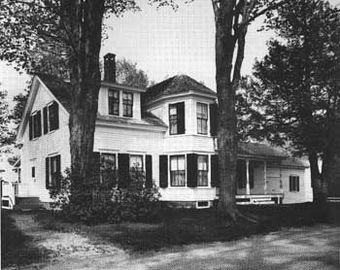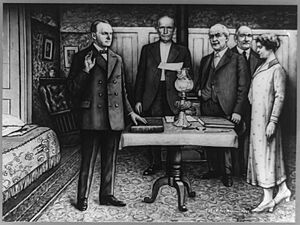Coolidge Homestead facts for kids
|
Calvin Coolidge Homestead District
|
|
|
U.S. Historic district
Contributing property |
|

The Coolidge Homestead, 1976.
|
|
| Lua error in Module:Location_map at line 420: attempt to index field 'wikibase' (a nil value). | |
| Location | Plymouth Notch, Vermont |
|---|---|
| Area | 130 acres (53 ha) |
| Built | 1872 |
| Part of | Plymouth Historic District (ID70000084) |
| NRHP reference No. | 66000794 |
Quick facts for kids Significant dates |
|
| Added to NRHP | October 15, 1966 |
| Designated NHLD | June 23, 1965 |
| Designated CP | December 12, 1970 |
The Coolidge Homestead, also known as the Calvin Coolidge Homestead District, is a special place in Plymouth Notch, Vermont. It was the childhood home of Calvin Coolidge, who became the 30th president of the United States. This is also where he took his first presidential oath of office. Calvin Coolidge lived here from 1876, when he was four years old, until 1887. He is buried nearby in the Plymouth Notch Cemetery.
Contents
The Story of the Coolidge Homestead
Calvin Coolidge's father, John Coolidge, bought this home. He made it bigger, changing it from a small farm house to the size and look it has today.
Even though Calvin Coolidge lived most of his adult life in Northampton, Massachusetts, he often came back to the homestead to visit his family. He was staying here when President Warren G. Harding passed away.
The Presidential Oath
After President Harding's death, Calvin Coolidge needed to take the Oath of Office to become president. His own father, who was a notary public, swore him in. This important moment happened right in the family's parlor.
His father did not want to change the house much. Because of this, the house still looks the same as it did on the night Coolidge took the oath. Some of the furniture is even the same.
You can see the "Inaugural Room" through glass. Visitors can stand in a special area and view the lamp, Bible, and table used in the ceremony. Everything is placed exactly where it was during that historic event.
Exploring the Homestead District
The Calvin Coolidge Homestead District is a large area with many historic buildings. It is like stepping back in time to see how people lived long ago.
The district includes:
- A Visitors Center, where you can learn about the site.
- The Coolidge Homestead, the main house.
- A Farmer's Museum, showing old farming tools.
- The Wilder House and Wilder Horse Barn.
- The Old Coolidge Farmhouse, which also served as the Florence Ciley General Store and Coolidge Hall.
- The Coolidge Farm Shop.
- The Plymouth Cheese Factory, with a museum about making cheese upstairs.
- A One-Room Schoolhouse, like the ones children attended long ago.
- The Azro Johnson House.
- The Union Christian Church.
- The Carrie Brown Coolidge Garden, started by the President's stepmother.
- The Aldrich House.
- The Top of the Notch Cabins, which were built in 1927 for tourists.
- The Brown Family Farmhouse.
- The Plymouth Notch Cemetery, where the Coolidge family is buried.
A National Historic Landmark
This special district was named a National Historic Landmark in 1965. This means it is a very important place in American history.
Today, the Coolidge Homestead is part of the Calvin Coolidge State Historical Site. The state of Vermont takes care of it. They have worked hard to make the buildings look just as they did when Coolidge was president.
You can watch a simple video and see pictures of his life in the barn. The rooms in Coolidge Hall that he used as a "Summer White House" in 1924 have also been fixed up. A video of old newsreels from that time is also shown.
Visiting the Homestead
The site is located west and north of Vermont Route 100A in Plymouth Notch. It is open every day from 9:30 A.M. to 5:00 P.M. You can visit from late May to mid-October.
Four generations of the Coolidge family, including the President himself, are buried in the nearby Plymouth Notch Cemetery. The Calvin Coolidge State Park is also close by.
Images for kids
- Coolidge Hall
- Wilder Barn
- Wilder Horse Barn Exhibits
See also














